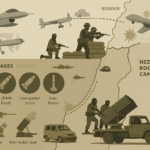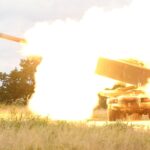General Atomics’ YFQ-42A collaborative combat aircraft completed its first flight on August 27, 2025, with the U.S. Air Force announcing the milestone the same day.
The aircraft took off from the Gray Butte test site east of Palmdale, California, where the company has long run Predator and Reaper development. The sortie marks the start of flight trials for the first production-representative prototype under the service’s Collaborative Combat Aircraft program.
The company’s air vehicle draws on the XQ-67A Off-Board Sensing Station lineage that flew in 2024. The Air Force earlier assigned formal mission design series to both program contenders, naming General Atomics’ jet YFQ-42A and Anduril’s prototype YFQ-44A.
“This milestone showcases what’s possible when innovative acquisition meets motivated industry. In record time, CCA went from concept to flight-proving we can deliver combat capability at speed when we clear barriers and align around the warfighter,” Secretary of the Air Force Troy E. Meink said in the service statement.
Company president David R. Alexander credited close work with the Air Force for bringing the jet to first flight a little over a year after the contract award. Defense officials report that the aircraft now moves from company-led developmental sorties to service-managed test points at established ranges.
YFQ-42A first flight details and test locations
The initial takeoff occurred from Gray Butte, a private field owned by the manufacturer and routinely used for early risk reduction.
Public video posted by senior Air Force leaders showed the prototype departing a California runway and climbing out cleanly before entering a conservative pattern. According to industry sources, post-flight readouts focused on engine performance, flight control response, datalink stability and basic envelope checks at safe speeds and altitudes.
The service plans to move follow-on trials to Edwards Air Force Base, California. There, test teams will run structured performance workups that include handling qualities, stores integration checks and reliability growth tasks.
After developmental events at Edwards, the aircraft will enter operational assessments by a dedicated unit at Nellis Air Force Base, Nevada. That unit, recently elevated to a squadron-equivalent Experimental Operations Unit within the 53rd Wing, is tasked to evaluate employment concepts, tactics and human-machine teaming in realistic sorties with frontline fighters.
General Atomics built the YFQ-42A around a common engine and fuselage architecture intended to support multiple mission kits. The current build aims at Increment 1 tasks, with the Air Force emphasizing air-to-air roles first. Test cards will verify carriage and release of air-to-air weapons from internal or external stations and confirm basic sensor cueing from off-board sources. The service has signaled interest in scalable configurations that can shift from sensing roles to weapons-carrying roles without a deep rework of the airframe.
Anduril, the other funded participant, cleared ground testing in May and said its YFQ-44A “will begin flight testing soon.” That aircraft derives from the company’s Fury line, which already completed engine runs and taxi trials. The Air Force expects both vendors to fly similar early profiles before expanding to multi-ship events with fighter escorts.
Program timeline and production decision in fiscal 2026
The department plans a competitive Increment 1 production decision in fiscal 2026. Officials have kept open whether the outcome selects one design or procures quantities from both. Statements over the past year suggest the service will base split buys, if any, on data gathered in flight: availability rates, performance against threshold objectives and the maturity of autonomy stacks and control interfaces.
Before the decision point, both prototypes will complete developmental testing at Edwards, then transition to the Nellis assessments. Those operational events aim to answer narrow questions tied to combat utility.
Test leaders will grade how quickly fighter crews can task the drones, how well datalinks hold under jamming, and how reliably the aircraft return to base with minimal maintenance. Defense officials confirm the evaluation will incorporate mixed packages with F-22, F-35 and other mission aircraft to stress deconfliction and timing.
The Air Force set the initial Increment 1 mission to augment air-to-air loadouts. In effect, the drones will carry extra missiles, extend sensor coverage and help preserve a fighter’s internal weapons for later shots. The next sequenced increment has not been formally detailed, though public remarks indicate a lower-cost batch oriented toward “affordable mass.” It points to larger production runs at lower unit price, once the test community nails down minimum viable configurations that meet the fleet’s needs.
CCA basing plan Beale Air Force Base and unit roles
The service named Beale Air Force Base, California, as the preferred location for a CCA Aircraft Readiness Unit. The ARU will field aircraft for operational use and deploy them worldwide. It is not intended as a training schoolhouse. The Air Force described a leaner manning model than legacy remotely piloted aircraft squadrons, citing lower sortie counts required to preserve readiness and simplified maintenance bands. Airspace access near Beale, plus proximity to key test ranges, supports that concept.
At Nellis, the newly formalized Experimental Operations Unit will keep its focus on evaluation and tactics development. The EOU previously operated as a detachment. Now, it holds squadron-level authorities to plan, execute and assess complex events.
The unit reports to the 53rd Wing, which manages operational tests for combat aircraft and weapons across the Air Force. That placement lets test planners pair CCAs with fighters, tankers and command-and-control assets during large-force trials.
According to industry sources, the service also expects limited contractor logistics support during the early fielding window. The goal is to pivot to organic sustainment templates as reliability stabilizes. The ARU construct should allow that handoff without disrupting line units that will employ the capability overseas.
Funding lines for CCA in fiscal 2026 and reconciliation update
Budget documents and public testimony identify two primary funding streams for CCA in FY26. The Department’s base request for the Air Force lists only $111 million explicitly tagged to CCAs in the initial submission. Lawmakers and senior leaders then pointed to a one-time reconciliation package that adds $678 million, bringing the available FY26 total to roughly the $790-$800 million range.
Separate reporting through June and July mapped larger reconciliation adds across air dominance programs, with the Air Force’s RDT&E accounts increasing sharply above the base plan. The department’s public budget overview shows a broad top line increase for FY26, but CCA’s discrete increment depends on both chambers aligning on the reconciliation figure and conference outcomes.
Defense officials confirm the program remains paced to the FY26 production decision regardless of the exact final split between base and reconciliation funding, given the current test schedule.
The Air Force also distributed work across installations to reduce schedule friction. Edwards will handle developmental flight test, Nellis will run operational assessments, and Beale will field the readiness unit.
The production decision window ties directly to data the service expects to collect between now and mid-FY26. Reliability growth curves, sortie generation rates, and mission-system stability will weigh more than one-off performance feats. Our analysis shows the department wants a repeatable, serviceable capability over a headline speed record, which is consistent with how operational test habitually scores systems ahead of procurement.
The operational concept under test keeps pilots in command of a small formation that includes one or more CCAs. Early statements describe a manageable ratio for fighter crews, often cited as up to six drones under control. That figure will be validated during the Nellis assessments. Tasking should be as simple as a bearing, altitude and target set, with the drone’s onboard software handling the mechanics inside that order. Trials will test how much training aircrews need before they can use the system smoothly in real missions.
The service has signaled a willingness to keep competition alive beyond the first buy. Companies not selected for the initial funded phase may still enter later increments at their own expense, then compete for production awards once they hit the demonstrated thresholds.
Anduril’s pending first flight remains the next near-term marker. The company reaffirmed its schedule after General Atomics’ sortie and congratulated its rival. The Air Force has kept the same message. Both prototypes run through one evaluation pipeline and face the same test gates ahead of the FY26 decision. The calendar still leaves room for several dozen flights per airframe, as well as integration events with fighters and range emitters.
The YFQ-42A’s first flight didn’t change the test plan’s objectives. With a jet in hand Edwards crews can start captive-carry checks for weapons, run radar compatibility tests and harden links under controlled interference. Nellis planners can build EOU scenarios that blend CCAs into tanker-backed packages with escorts and standoff shooters. Beale’s ARU will continue to prepare so it can receive aircraft as soon as the service clears that step.
REFERENCE SOURCES
- https://www.ga.com/ga-asi-marks-another-aviation-first-with-yfq-42a-cca-flight-testing
- https://www.af.mil/News/Article-Display/Article/4287627/collaborative-combat-aircraft-yfq-42a-takes-to-the-air-for-flight-testing/
- https://www.defensenews.com/air/2025/08/28/first-flight-tests-begin-for-air-forces-drone-wingmen/
- https://www.defenseone.com/defense-systems/2025/08/general-atomics-collaborative-combat-aircraft-notches-first-flight/407741/
- https://www.airandspaceforces.com/cca-general-atomics-drone-first-flight/
- https://defensescoop.com/2025/08/27/general-atomics-cca-begins-flight-tests-air-force-drone-program/
- https://www.af.mil/News/Article-Display/Article/4171208/daf-begins-ground-testing-for-collaborative-combat-aircraft-selects-beale-afb-a/
- https://www.nellis.af.mil/News/Article/4208500/experimental-operations-unit-activated-accelerating-collaborative-combat-aircra/
- https://breakingdefense.com/2025/05/air-force-picks-beale-to-host-cca-drone-wingmen-aircraft-readiness-unit-begins-ground-testing/
- https://www.saffm.hq.af.mil/FM-Resources/Budget/Air-Force-Presidents-Budget-FY26/
- https://www.defenseone.com/technology/2025/06/how-drone-warfare-fares-2026-budget/406046/
- https://www.airandspaceforces.com/air-force-house-senate-defense-policy-bills/
- https://insidedefense.com/daily-news/majority-cca-spending-fy-26-relies-reconciliation-air-force-rdte-sees-big-bump/
- https://theaviationist.com/2025/06/06/cca-experimental-operations-unit-nellis/
- https://www.twz.com/air/yfq-42-fighter-drone-collaborative-combat-aircraft-has-flown-for-the-first-time



